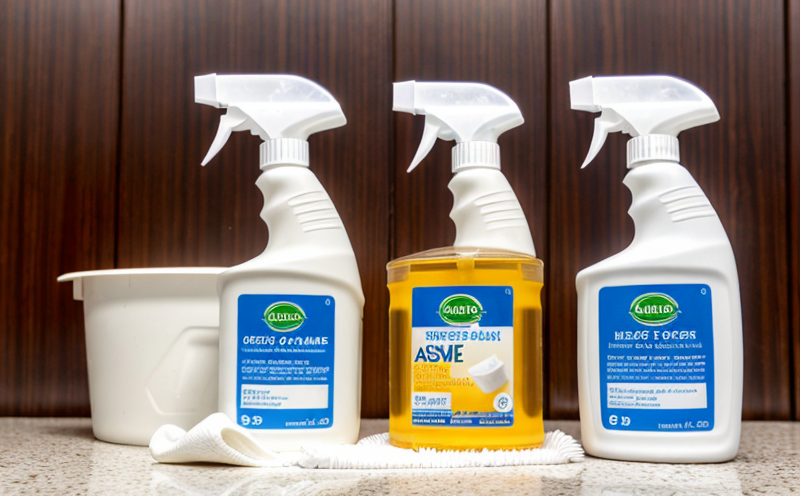EPA 850 Microbial Safety Testing of Cleaning Products
The Environmental Protection Agency (EPA) regulates chemicals and their use in products to ensure public safety. One such regulation pertains to the microbial safety of cleaning products as specified by EPA Method 850, which evaluates the presence and efficacy of microorganisms in cleaning agents.
EPA 850 is designed to assess the potential for harmful microorganisms to be transmitted through contact with a cleaned surface. This method is essential because improper cleaning can lead to the spread of pathogens, causing illness or infection. The test aims to ensure that cleaning products not only remove dirt and grime but also eliminate harmful microbes effectively.
The testing protocol involves several steps, including sample preparation, inoculation with specific microorganisms, incubation, and detection. The microbial species used in this testing are typically those known to be prevalent in indoor environments or those that have been identified as potential health hazards. Common organisms tested include Staphylococcus aureus, Pseudomonas aeruginosa, Escherichia coli (E. coli), and Salmonella.
The process begins with the preparation of the cleaning product sample. This involves diluting the product according to standard procedures specified by EPA Method 850. Once prepared, the samples are then inoculated with the selected microorganisms. The samples are incubated under conditions that favor microbial growth, allowing any present pathogens to multiply.
Following incubation, the samples undergo a series of assessments aimed at determining both the initial and residual levels of microorganisms. This evaluation helps to establish whether the cleaning product is effective in reducing microbial contamination. Residual testing measures how well the product maintains its efficacy over time, which is crucial for products that are used frequently.
The results of EPA 850 testing are reported based on established thresholds and acceptance criteria defined by the EPA. Compliance with these standards ensures that cleaning products meet government regulations and are safe for use in public spaces or environments where hygiene is paramount.
Understanding the significance of this test is crucial for quality managers, compliance officers, R&D engineers, and procurement professionals who need to ensure their products comply with regulatory requirements. This testing not only protects consumers but also enhances brand reputation by demonstrating a commitment to safety.
Why It Matters
The importance of EPA 850 microbial safety testing cannot be overstated, especially in sectors where hygiene and sanitation are critical. In healthcare facilities, for instance, the spread of pathogens can lead to outbreaks that compromise patient care and increase healthcare costs. Similarly, in food service establishments, any contamination could result in product recalls or legal action.
By adhering to EPA 850 standards, companies demonstrate their commitment to public health and safety. This compliance also provides a competitive edge by ensuring products meet the highest hygiene standards expected by consumers and regulatory bodies. Additionally, it helps brands build trust with customers who prioritize cleanliness and safety in their purchasing decisions.
For R&D engineers, this test is essential for developing new cleaning formulations that are both effective and safe. By understanding the microbial composition of a surface post-cleaning, they can refine formulas to maximize pathogen removal without compromising efficacy or causing irritation. For quality managers overseeing production processes, it ensures every batch meets regulatory standards.
The implications extend beyond just product safety; they also impact environmental sustainability efforts. Effective cleaning products reduce the need for multiple applications and minimize waste from ineffective formulations. This aligns with broader corporate goals towards sustainable practices and responsible resource use.
Industry Applications
EPA 850 microbial safety testing finds extensive application across various industries, particularly those where hygiene standards are critical. Healthcare facilities, including hospitals and clinics, rely heavily on this test to ensure that cleaning agents used in patient care areas do not introduce or exacerbate infections.
In the food industry, especially for restaurants and food processing plants, EPA 850 testing is crucial to prevent cross-contamination between raw products and prepared meals. This ensures that consumers receive safe, uncontaminated food items free from harmful microorganisms.
Public spaces such as schools, office buildings, and public transportation also benefit significantly from this testing. These environments see high foot traffic, increasing the risk of pathogen transmission if cleaning protocols are not stringent enough. By adhering to EPA 850 standards, these establishments can maintain a safer environment for occupants.
Furthermore, manufacturers of household cleaning products use EPA 850 testing as part of their quality assurance processes. This helps them ensure that each product meets the required efficacy and safety levels before reaching market shelves. The results from this test provide valuable data on how well different formulations perform against various types of microorganisms.
For hotels, resorts, and other hospitality providers, EPA 850 testing ensures that guest rooms and public areas are kept clean and free from harmful pathogens. This enhances the overall experience for guests while reducing the risk of health issues resulting from poor hygiene practices.





